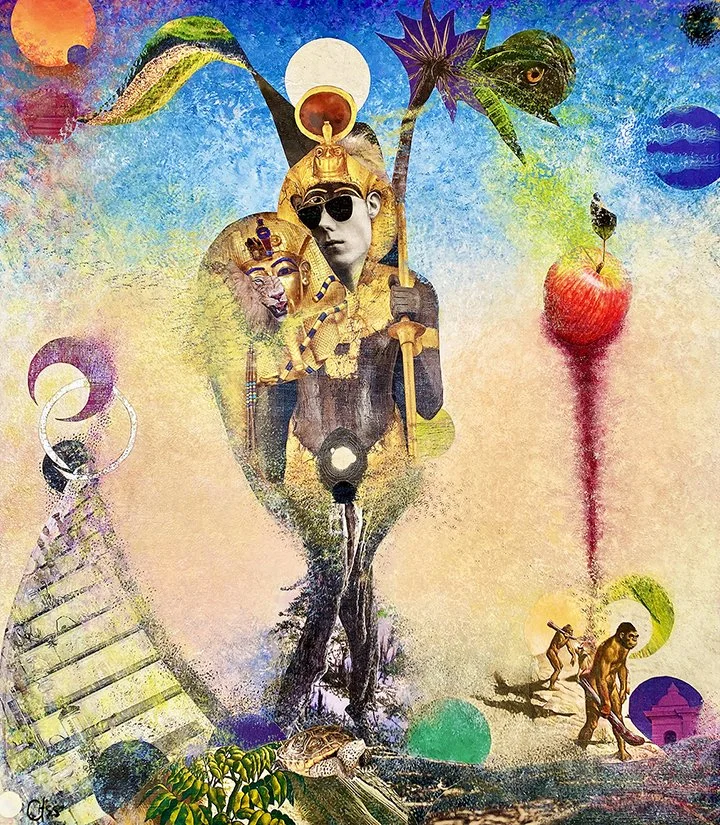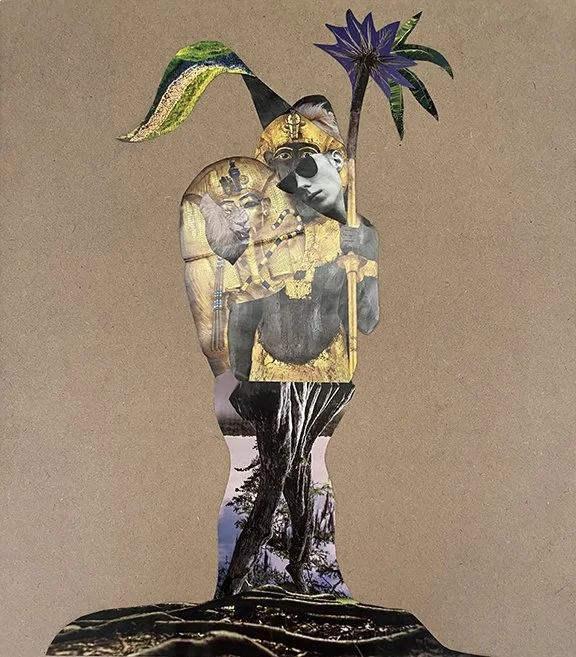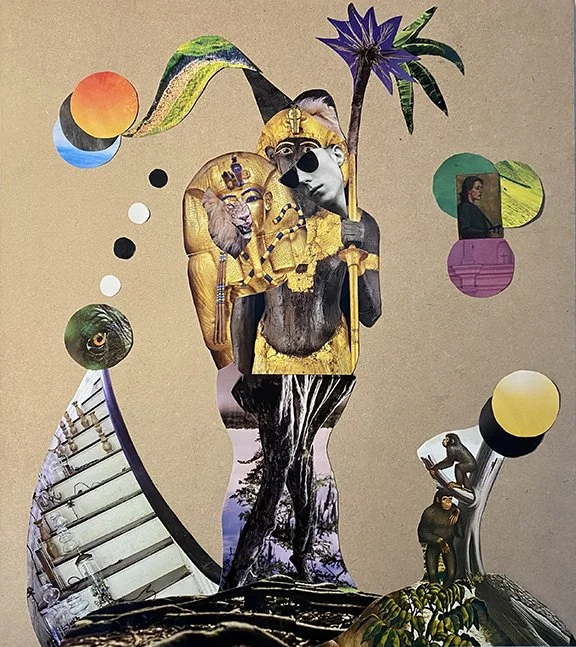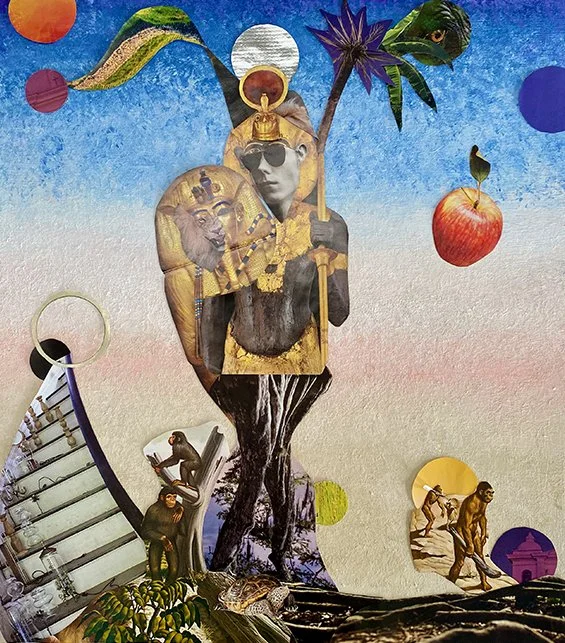Some Kind of Psychopomp
Some Kind of Psychopomp, by Christy Higgins, 2023, Mixed-media collage on wood box panel. Original artwork and prints available.
There are many things I enjoy about the creative process, but perhaps my favorite is its ability to connect me with my subconscious and unconscious mind. This, in turn, expands me by teaching me things about myself and the world. The source of those teachings, however, does not come directly from the concrete, rational, material side of life, but rather from the subjective interior realm of psyche and spirit, which “speaks” (vibrates or intones) to us through our non-rational minds in the language of intuition, emotion, metaphor, myth, poetry, music, song, dream, and vision. These are the access points to the creative fountain which springs not from logic (rational mind), but from eros (non-rational mind). When we’re courting the muse, we are hoping to connect with the “muse-ic” that arises from within us, which guides us steadily in a flow state when we release ourselves to it.
It often happens when I’m playing around with the enormous possibilities available through collage that something emerges from the chaos of my seemingly random placing of paper and grabs my attention. The first photo I take of a new image is usually a record of that moment—below is that photo of this emerging character.
Finding the inspiration for a new image is sometimes the easiest part. I have found, however, that for a long while after the initial inspiration, nothing comes quite as easily. This is where the perspiration part of art comes in.
I navigate through this period by intuition to add, subtract, or move images around.
Eventually (days, weeks, or months later), the final image comes into focus, and I can begin to perceive the potential messages and various meanings it may have for me.
It is my belief that art becomes a mirror for its creator and each viewer through a psychological process called projection. Psychology Today defines projection as the process of displacing (mostly unconsciously) one’s feelings onto a person, animal, or object. That is a very basic description of projection, which is a deep and fascinating topic, but for our purposes here, it’s enough to say that it’s the filter through which we see the world.
So what do I see in this image/mirror? The short answer is: I don’t quite know yet. I’m writing about it in order to explore it more consciously.
Visually, I like and am intrigued by this piece, but I also feel ambivalent about it; while I find it endearing, it also makes me apprehensive. I’m not sure why, but I think it’s because this character seems like both a trickster and a psychopomp.
In mythology, the trickster is usually some type of amoral shapeshifter (not immoral, as in the devil) hence the various disguises he seems to be wearing. According to Lewis Hyde in Trickster Makes This World: Mischief, Myth, and Art, tricksters are complex figures in polytheistic cultures. They steal new technologies from the gods and bring them as gifts to humans to help them adapt and evolve on Earth, but they also disguise themselves and play tricks. Tricksters, sometimes known for getting caught in their own traps, seem to be an embodiment of contradiction and paradox itself, whereas the Psychopomp in mythology is the guide of souls through the Underworld journey.
In Classical Greek mythology, Hermes, son of Zeus and the nymph Maia, is both: a psychopomp and messenger of the gods, as well as a trickster. In Jungian psychology, which reinterprets myth as symbols of the unconscious psyche, the psychopomp becomes a mediator between the unconscious and conscious realms. It is symbolically personified in dreams as a wise person, or sometimes as a helpful beast.
According to Jenna Leela, PhD on nondualself.com, this mediation is essential in Jungian psychology for the process of individuation, the journey toward realizing and integrating the various aspects of the psyche into a harmonious whole. She goes on to say,
“…a psychopomp is a spiritual guide shepherding souls through their
transformative journeys. The ability of Hermes to traverse different worlds
mirrors the individuation process, where the individual reconciles and
integrates unconscious contents into consciousness.
Hermes represents the alchemical process of transforming base elements of
our psyche into the gold of self-realization and wisdom.
He is a symbol of transformation. He is the communicator between realms of
existence, a concept that parallels the process of self-realization where we
communicate with different parts of ourself. This internal dialogue and
reconciliation lead to a more profound understanding and harmony within
the self.
Hermes is also characterized by his embodiment of duality and paradox. He
is the trickster, the messenger, the guide, and the mediator, roles that
encompass a range of human experiences and traits. This duality is
significant in the journey towards self-realization, as it involves embracing
and integrating contrasting aspects of one’s personality. The reconciliation of
these dualities, such as the anima and animus, the shadow and the ego, is a
central theme in Jung’s concept of individuation.
Daryl Sharp, a distinguished Jungian analyst, links Hermes to the animus –
the masculine component of a woman’s personality. Sharp suggests, ‘In
mythology, this aspect of the animus appears as Hermes, messenger of the
gods; in dreams, he is a helpful guide’ (Sharp, 1991). This association with
the animus suggests that Hermes symbolizes a key aspect of psychological
development and integration, particularly in the individuation process for
women.”
That is to say, according to this view, this character may be a symbol of my animus; my own soul guide.
What does that mean for me? What is my psychopomp guiding me toward integrating within myself, and is he intending to trick me into my transformation? What are the anima and the animus and how do they impact our emotions, minds, behavior, and attitudes? These are all questions I continue to ask myself as I contemplate the meaning of a work of art.
I just finished this piece a week ago and I need more time for the image to reveal its depth and layers. For me, this one hints at Hermes, animus, alchemy, duality vs. non-duality, the mythical dimension, unconscious drives, energies, and subjective realities. But what the specific message may be for me has yet to reveal itself, if there is any such thing. The ambiguity itself feels mercurial, which is entirely appropriate since Mercury is the Roman name for Hermes, and is also a common trait of the trickster.
These are the themes that come to my mind and the associations I make with this image, which I imagine will shift and reveal different nuances of meaning over time. As I grow and change, so do my projections (which are the sum total of the current conscious and unconscious beliefs I’m holding at any given moment). I will write more on these themes and expand on the depth of their meaning in future posts, as I continue to explore how ancient myth, depth psychology, and personal storytelling spiral around universal motifs that illuminate the patterns from which the human condition arises.
RESOURCES:
Psychology Today - Definition of Projection
Hyde, Lewis. Trickster Makes This World. Farrar, Straus and Giroux, 2010
nondualself.com, Jenna Leela, PhD
Sharp, Daryl. Jung Lexicon. Inner City Books, 1991






